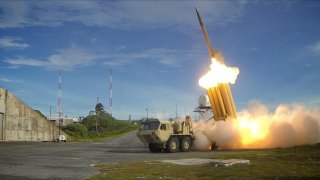Russia Pledges to Preserve Its Advantage in Hypersonic Weapons
But how long will that last with the U.S. Army nipping at its heels?
“Preserve the advantage,” were the words used by Russia’s Deputy Prime Minister Yuri Borisov when he was talking about his country’s position in the global hypersonic weapons arms race which continues to unfold at lightning speed. Is Russia number one in hypersonic weapons? Borisov says “yes,” according to a report by Russia’s TASS news agency.
“We have been trying to remain on par or chase the leading weapon designs of Western states for years, and, for the first time in all this time, we dashed ahead in the development of hypersonic weapons and weapons on new physical principles, which use new types of engines—compact low-power nuclear power plants. Right now, we have a serious advantage in this regard over Western states, and we will try to preserve this advantage,” Borisov said.
Many members of the Russian media and international media have written extensively about Russia’s hypersonic weapons, partly because their existence has been highlighted regularly by Russian leaders. For example, Russia is known to be testing a submarine-launched hypersonic cruise missile called 3M22 Zircon. Certainly, a hypersonic attack from the ocean introduces an entirely new sphere of attack positions. Something similar could be said of Russia’s bomber-launched Hypersonic weapon called the Kinzhal.
“[Russian weapons] comply with the main weapon and military vehicles development trends, as they move towards precision weapons, unmanned systems, and robotization,” Borisov added.
While specifics regarding performance parameters, range, speed, maneuverability and guidance technology of Russian hypersonic weapons are likely difficult to determine, continued Russian superiority in the realm of hypersonics is by no means a certainty. The United States continues to make massive and rapid progress in its development of new Hypersonic weapons. For instance, the Army’s Long Range Hypersonic Weapon is on track to be ready for war by as soon as 2023. The LRHW will be road-mobile and air-deployable onboard a C-17 Globemaster III.
Initial configurations include plans to deploy a missile battery of four launchers and a battery operations center. Interestingly, the LRHW is a joint Army-Navy weapon that uses a common warhead projectile for ground and maritime attack. Each launcher contains two hypersonic missiles, indicating a total of eight LRHWs in a battery.
“Our all up round is a 34-inch booster which will be common between the Army and the Navy. We will shoot exactly the same thing the Navy shoots out of a sub or ship,” Robert Strider, the deputy of the Army’s Hypersonic Project Office, told an audience on Aug. 11 at the Space and Missile Defense Symposium in Huntsville, Alabama.
If the Army sends a battery capable of firing eight LRHWs to a sensitive location, and if it had the ability to quickly power up and launch from various locations via a mobile launcher, then that would put enemy forces and their assets on land and at sea at great risk of destruction.
What much of this amounts to is simply that, should it be true that Russia does maintain a tactical advantage, then that advantage gap may be closing.
Kris Osborn is the defense editor for the National Interest. Osborn previously served at the Pentagon as a Highly Qualified Expert with the Office of the Assistant Secretary of the Army—Acquisition, Logistics & Technology. Osborn has also worked as an anchor and on-air military specialist at national TV networks. He has appeared as a guest military expert on Fox News, MSNBC, The Military Channel, and The History Channel. He also has a Master's Degree in Comparative Literature from Columbia University.
Image: Flickr / The U.S. Army

